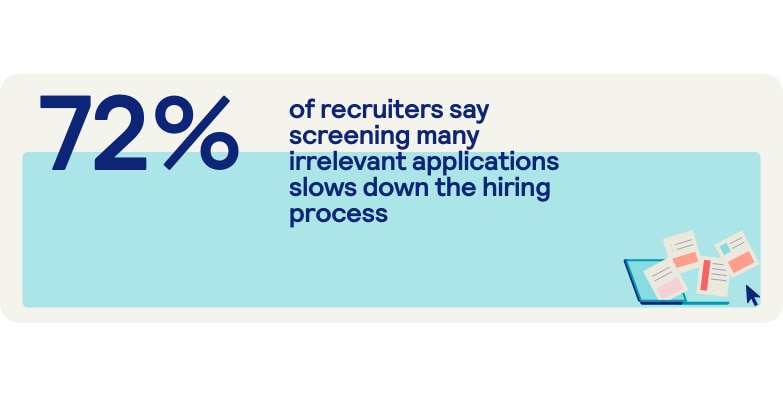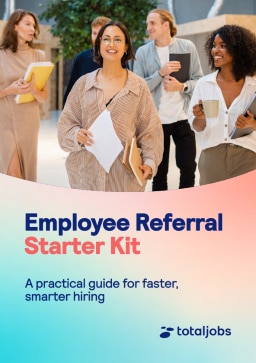
Building an employee referral scheme that actually works
Table of Contents
- What is a referral scheme?
- Why are referral schemes effective?
- Best practices
- Leveraging referrals for success
- FAQs

Employee Referral Kit
In today’s competitive hiring landscape, employers are constantly seeking more efficient, effective ways to secure top talent. One often-underused strategy that continues to deliver strong results is the employee referral scheme.
In this guide, we’ll explore the key advantages of implementing employee referral schemes as part of a wider recruiting strategy and how to make yours successful.
What is a an employee referral scheme?
An employee referral scheme is a structured programme designed to encourage employees to recommend qualified candidates for open roles with their current employer.
These recommendations are typically incentivised with bonuses, recognition, or other rewards if the referral leads to a successful hire.
Referral scheme example
Let’s say a software company needs a new senior programmer with experience in a specific development tool. Their employee referral scheme might work like this:
- Employees know they get a £1,000 referral bonus if someone they refer lands a role
- Current developers at the company have their own networks of friends and former colleagues, and they know their capabilities
- They can either pass the contact details of the referred candidates straight to the hiring team, or the candidate can name the referring employee on their application
- The candidates put forward are likely to have the required capabilities with the required tools, meaning the hiring team now has a pool of pre-screened, suitable candidates
- Once a candidate is hired, the employee who referred them receives a bonus
Why are employee referral schemes effective?
According to our research, 68% of large businesses and 52% of SMEs rank employee referral schemes among their top-performing recruitment channels, often more effective than social media or even some paid listings.
Let’s explore why.
Higher retention rates
Referred candidates tend to stay longer. Because they’ve been vetted by existing employees and likely have a clearer picture of the organisational culture and expectations, they are more likely to be a good fit, and stay the course.
This not only reduces future recruitment costs but also contributes to a more stable and engaged workforce. High retention is particularly valuable in a climate where 28% of candidates drop off during the hiring process, often due to poor communication or misaligned expectations.
Faster and more cost-effective talent acquisition
Referral schemes can significantly cut down on the time spent screening irrelevant applications, one of the top frustrations among recruiters, with 72% reporting it as a major drain on their time.
Instead of wading through dozens of underqualified CVs, referrals tend to bring in more pre-qualified, relevant candidates, often reducing the time-to-hire and admin burden.

With recruiters spending 17.7 hours per vacancy on administrative tasks alone, any channel that improves upfront candidate quality can yield massive efficiency gains.
Confidential, streamlined process
It’s important to structure referral schemes so that all submissions remain confidential. This protects both the referring employee and the candidate.
Referrers should not be given updates on a candidate’s progress through the hiring funnel, not only to maintain professionalism, but also to uphold data privacy standards and avoid workplace awkwardness.
Cross-team collaboration and engagement
A great secondary benefit of referral programmes is that they encourage employees across departments to engage in the organisation’s long-term growth.
Referrals often come from different functions or social circles than those targeted by traditional recruitment ads, bringing a broader range of experience and perspectives into existing talent pool.
Best practices for a successful employee referral scheme
So, the benefits of a well-structured recruitment referral scheme are clear, but how do you put one together? Here are some steps you can follow to create an effective referral scheme.
1. Keep the process simple
Simplicity is crucial for the success of any employee referral scheme. If the process feels complex or time-consuming, employees are far less likely to participate. That’s why it’s important to streamline every step.
This can be achieved by:
- Providing clear instructions on how to refer potential candidates, whether through a form, email, or your HR software.
- Using user-friendly digital tools (such as an ATS with referral tracking capabilities) so employees can submit referrals in under two minutes.
- Minimising back-and-forth communication or requests for additional information. Ideally, the referral process should be intuitive enough to require no training.

Tip: A frictionless experience encourages more frequent participation and keeps the referral scheme top-of-mind.
2. Define eligibility and expectations clearly
Make sure employees know which roles are open to referral, who qualifies, and any limits or exclusions. For example:
- Can they refer someone for a senior role?
- Can they refer former employees?

Tip: Addressing these upfront avoids confusion and disappointment further down the line.
It’s also important to be clear about how and when incentives are paid out (e.g. after 3 months of employment), to avoid misunderstandings.
3. Promote the programme internally
No matter how well-designed an employee referral programme is, it won’t be effective if employees aren’t aware of it, or just forget it exists.
A range of channels can be used to highlight these programmes internally, including:
- Monthly newsletters
- Slack or Teams announcements
- All-hands and team meetings
- Intranet or HR portal banners
Furthermore, it can also help to celebrate wins. Share stories of successful referrals, include quotes or testimonials from the referring employees, and highlight the impact they’ve made.

The best referral programmes are simple, visibible, and consistent. If employees know how to take part and feel valued for contributing, referrals will come naturally
Lorraine Morrin, People Partner Lead Mid-Markets, The Stepstone Group
4. Offering meaningful incentives
Rewards are a major driver of participation, but what’s considered “meaningful” will vary by organisation and team culture.
Monetary bonuses remain effective, particularly when offered in stages (e.g., part at hire, part after probation). But the power of non-financial incentives should not be underestimated. These can include:
- Public recognition during company meetings
- Extra annual leave days
- Charitable donations in the employee’s name
- Experience-based rewards, like event tickets or team outings
5. Follow up and give feedback (when appropriate)
While maintaining confidentiality is essential and referrers shouldn’t be given updates on the status of their candidate, that doesn’t mean they should be completely ignored post-submission.
Instead, consider:
- Sending an automated thank-you message acknowledging the referral.
- Providing generic updates such as “Your referral is progressing” or “Thank you – we’re reviewing their application.”
- Celebrating referrals that turn into hires.
Acknowledging effort, even if the candidate isn’t hired, makes employees feel that their contribution is valuable and taken seriously.
6. Track and optimise the programme
To maintain long-term impact and relevance, it’s vital to monitor performance and refine the programme based on data-driven insights. Just like any other recruitment channel, continuous improvement is key.
This can be done by identifying and measuring key performance indicators (KPIs) for the programmes, such as:
- Number of referrals submitted
- Referral-to-hire ratio
- Time-to-hire for referral candidates
- Retention rates of referral hires

Tip: Schedule regular (e.g., quarterly) reviews of referral programmes to ensure they stay aligned with your evolving hiring goals, team structure, and organisational priorities.
7. Make the programme part of onboarding and culture
Finally, try and introduce the referral scheme to new team members during onboarding so it becomes embedded in your culture from day one.
People are most connected to their external networks when they join a new employer, making it the perfect time to spark referrals that lead to successful hire.

Tip: Include a short overview of your referral scheme in your onboarding pack or welcome session and follow up with a reminder during their first month.
Leveraging referrals for hiring success
Employee referral schemes offer a practical, high-impact solution to common recruitment challenges like slow processes, poor candidate fit, and high turnover. With referred hires bringing stronger retention and faster onboarding, they help teams hire smarter, not just faster.
Frequently asked questions (FAQs)
What is an employee referral scheme?
An employee referral scheme is a structured programme where current employees recommend people in their network for job openings. If the referral results in a successful hire, the employee may receive a reward or recognition.
Why are employee referrals effective in recruitment?
Referrals often result in faster hiring, better cultural fit, and higher retention rates. They reduce time spent screening unqualified applicants and help recruiters access trusted candidates more quickly.
What incentives work best in referral schemes?
Monetary bonuses are common, but other incentives like extra leave, public recognition, or charitable donations in the employee’s name can also be effective.
Can small businesses benefit from referral schemes?
Absolutely. Referral schemes help SMEs compete with larger firms by reducing hiring costs and accessing high-quality candidates without relying heavily on external job boards.
Receive the latest recruitment resources and
advice to boost your hiring
By providing us with your details you agree to our privacy policy and for us to keep you updated with the latest news, events,
and special offers from Totaljobs.








